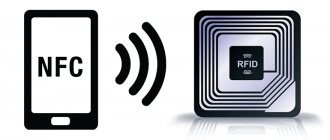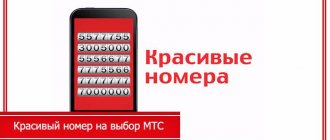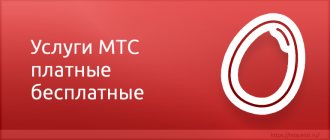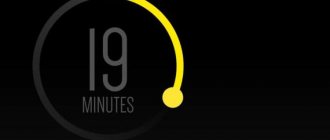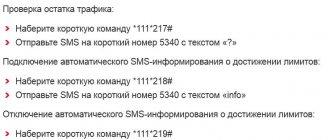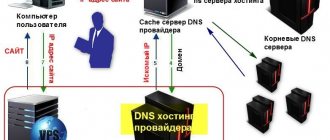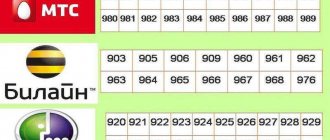Every modern mobile user, regardless of the operator providing the service, uses various commands that allow them to perform one or another action on their mobile device. Using queries entered in a line on the dial panel, you can, for example, check your tariff, find out your account balance or other information, activate a certain service, etc. Many people use separate combinations every day, including asterisks and hash marks, but not all are aware of what USSD commands are and may not even realize that they are constantly using them. Let's look at how requests work, what can be done with their help, and also give examples for different telecom operators.
What are USSD commands?
USSD is a service that operates by default in GSM networks and provides user interaction with the service department in the mode of sending short messages in real time.
The abbreviation USSD stands for Unstructured Supplementary Service Data, which means “unstructured additional service data”.
This method of information exchange is characterized by high speed, which provides an instant response to requests, in contrast to SMS technology, which is also a cellular communication standard, but uses an intermediate database and is generally used for the exchange of messages between subscribers. A similar service is IVR (Interactive Voice Response), while in USSD voice connections are not used, only the signaling channel is used. Thus, information exchange via the USSD protocol will be the most efficient.
Considering what USSD is, it should also be noted that the option works on any phone and is basic, regardless of the operator. Short messages begin with the * symbol and end with the hash symbol #, while asterisks can be additionally included in the combination, the length of the request corresponds to no more than 182 characters, although usually the command is much shorter and does not even exceed 20 characters. When the subscriber enters a certain sequence of characters formed in the form of a USSD command, a session is created in the GSM network, within which a dialogue is conducted between the subscriber and the telecom operator.
Internet
The list of MTS commands is designed for data transfer and communication on the network. In order to find out how much Internet traffic is left in the package, you need to enter the code *217# on your smartphone. If you have run out of your main traffic package, you can connect an additional one. To do this you need to enter the code *111*936#.
A list of useful codes for enabling and disabling traffic packages has also been developed. You can find out more about them in the corresponding section on the website or at the office of the mobile operator.
Purpose of USSD commands
Through queries, the user is able to:
- Find out about your account status, tariff, connected services, view your number, etc.
- Manage balance and expenses (make payments, transfer funds to other subscribers and perform other financial transactions).
- Manage data (connect/disconnect services, switch to another tariff).
- Interact with services available on the server, receive automatic Internet settings and much more.
Request form in the form of a USSD command
The operator is subject to certain requirements for commands sent to the server. So, the subscriber must enter a sequence of characters in the dial panel field, where the code will begin with * and # at the end, after which he should press the call button. For example, many operators use the USSD request *100# to check the balance; after entering the combination, the subscriber will have access to this information on the screen of the mobile device. In addition, the request may contain prefixes separated from the main code by an asterisk, which allow you to select a parameter within the sent command (for example, *111*1#).
All supported codes are registered on the server, so if the combination is entered incorrectly, the user will see a notification that the request code is unknown. Also, when a character set is entered in an incorrect form, the server will report an error that the request form is incorrect.
Each mobile operator has its own set of supported codes that can be used for specific tasks, and they may overlap with combinations of other telecom service providers. It is better to remember the basic, frequently used commands. Those that are rarely required can be found on the operator’s website, where a complete list of supported combinations is posted.
Popular MTS combinations
The very first and most popular command from MTS is *111#. This command is used to open a portal in which each user can manage the tariff and options. If it is difficult to remember other commands, then you only need to remember this one. With its help you can find out everything you need, and even your mobile balance. The request replaces your personal account on the website and can be used in any region and even country. MTS USSD requests are not charged, which is very convenient.
If there are characters on your phone in messages and other parts of documents that cannot be read, then you need to enter *111*6*1#. Below are the most popular codes from the MTS Russian operator:
- Account verification is carried out by dialing the combination *100#.
- You can see what the funds were withdrawn for during the last 5 actions using the command *145#.
- You can quickly find out your mobile number using the code *111*10#.
- To check active paid options, use *111*11#.
- To check the current tariff, use *111*12#.
- You can find out about the remaining package offers by entering *217#.
- You can top up your balance using a bank card by requesting *115#.
This is only a small number of requests that the operator has. All details can be found on the website, and this article describes only the most common and necessary ones. Information on requests for tariff plans will be provided in the description of the tariff itself selected by the subscriber.
How does the USSD command work?
The way queries work is simple. As soon as the user has entered the command in the required form (remember that for the server to correctly interpret the combination of characters, the control characters * and # must be entered) and pressed the call button, the phone will send a signal to the server, which recognizes the command as a USSD request. The signal is routed and transmitted via TCP/IP protocols to the USSD application that interacts with the billing system database. Having received the information, the application sends it in the form of a USSD package to the user’s mobile device; the content is displayed on the screen in text format.
Thus, client interaction with a server application can take place in two scenarios:
- The information is read from the database, the subscriber receives an instant response to his request on the phone, and the session ends (for example, the subscriber finds out his mobile number, balance, tariff information, etc.).
- Changes are made to the database, the session continues until the subscriber ends (for example, the user enters the services menu, gets acquainted with the information and moves through the menu items and sub-items by pressing numbers corresponding to certain actions - a numbered list is available on the screen, using which navigation is performed). The session can be ended by pressing a certain number corresponding to the exit (usually 0) or by selecting the final action that will change the subscriber's information in the operator's database.
Let's look at a simple example of how to send a USSD request from a mobile phone:
- To check the balance on a mobile number using the service code, you need to enter the combination corresponding to this action (the combination of numbers may be different for each operator).
- Open the dial pad and enter the * symbol in the field, then the corresponding combination of numbers responsible for checking the account (for example, 100), after which we press the hash icon # and the call button.
- After a short time, balance data will be sent to your phone in the form of an SMS message or will appear on the smartphone screen as an interactive menu.
The benefits of combinations
The USSD request is very convenient to use, because by entering short commands you can quickly receive information, without the need to call the operator or send an SMS. In addition, using combinations, you can obtain the data of interest at any convenient time, 24 hours a day.
Using such codes you can control your mobile phone number. Network clients can send requests to other people to send money or simply call back.
For a more detailed consideration of combinations, you should indicate data for different operators in Russia.
Disabling USSD on your phone
The service, which offers the ability to communicate with the operator’s service application, is supported by default by any mobile device with the GSM standard, and there is no need to connect it or download additional software. The function belongs to the standard cellular communication options and is available on the phone immediately when the SIM card is activated, but you cannot disable USSD. If desired, the user can simply stop using this opportunity, for example, by choosing live communication with an operator or using the functionality of personal accounts or mobile software. There is no subscription fee for using the USSD service, so you don’t even have to worry about how to disable USSD on your phone.
Roaming
For those who like to travel or do it when necessary, MTS has also developed a list of useful commands.
| Team | Intelligence |
| *111*473# | All incoming calls are charged as in your home region, i.e. absolutely free. All outgoing calls will cost 3 rubles per minute. Connection is paid - 30 rubles. |
| *111*1031# | All Russia Smart - in any region you can communicate at home prices. Monthly payment – 200 rubles. |
| *419*1233# | Zero without limits - all calls can be received absolutely free. You need to pay 95 rubles for it every day. |
Requests in the form of USSD commands from different operators
Let's look at useful USSD requests from large telecom operators, most often used by users. For convenience, the data is presented in the table.
The subscriber number is entered in the format 9ХХХХХХХХХ (10 digits).
USSD requests are sent exclusively using a GSM connection; neither 3G nor LTE is required to use the function, and data exchange occurs instantly. Tariffs of telecom operators may change, new services may be added, which means the emergence of new commands for connecting them. The current list of USSD commands can always be found on the official website of the mobile operator.
Opportunities at zero
If a client runs out of money in his account, this does not mean that he is left without communication until it is replenished. MegaFon offers several solutions:
- connection for 1-7 days, presuming a certain amount of trust on the part of the operator - *106#;
- activation and management of "Pay whenever" (credit limit provided by the telecommunications company) - *550*1#. USSD command rest MegaFon - *550#;
- “Call me” - sending a free message to a subscriber of any Russian mobile service provider with a request to call back. The USSD code *144*subscriber number# is used;
- “Pay for me” is a similar request, only in this case you are asking another person to top up your account - *143*subscriber number#.
